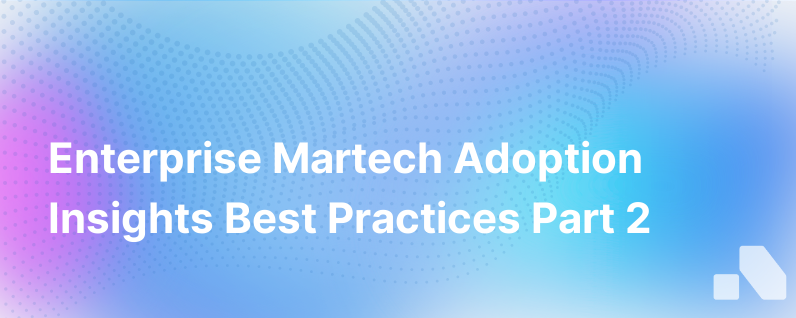Insights Best Practices Enterprise Wide Martech Adoption Part 2
Published on December 26, 2023 by Sawyer Middeleer
In the first part of our series on Insights Best Practices for Enterprise-Wide Martech Adoption, we discussed the critical role of executive buy-in, the need for a clear technological vision, and how proper vendor selection can make or break your martech stack efficiency. Now, we dive deeper into the specific methodologies and strategies that can facilitate widespread adoption of martech solutions in your enterprise, ensuring that the tools don’t just become part of the furniture, but gear propelling your company forward.
Employee Engagement and Training
A pivotal aspect of successful martech adoption is engaging the users — your employees. They are the ones interacting with the tools daily, and their proficiency and acceptance significantly influence the overall success of these tools.
1. Comprehensive Training Programs:
Provide structured and tiered training programs tailored to the different levels of user expertise. Begin with the basics, then move on to advanced concepts. Cater to individual learning styles by providing a mix of formats, such as hands-on workshops, webinars, and self-paced modules. Remember to include contextual training, illustrating how martech fits within their existing workflows and how it can simplify or automate their tasks.
2. Gamification and Incentives:
Introduce gamification strategies to make the adoption process more engaging. Set up leaderboards, badges, and rewards for milestones achieved within the martech tools. Incentivize your employees not just to use the tools, but to master them. This can trigger healthy competitiveness and build a culture of continuous learning and improvement.
3. Continuous Support and Resources:
Establish a support system with "martech champions" — individuals within different departments who demonstrate proficiency and can assist colleagues in troubleshooting or understanding best practices. To bolster this, have a central repository of resources — FAQs, troubleshooting guides, and best practices — easily accessible to all.
Data Management and Integration
Now, let's discuss the backbone of martech — data. Without data, even the most sophisticated tools are rendered powerless. The key here is not just gathering data, but ensuring it's integrated, actionable, and serves a single point of truth across the organization.
1. Standardize Data Management Procedures:
Implement organization-wide standards for data entry, hygiene, and analysis. Regular data audits to prevent decay, uniform tagging and categorization, and a common language for metrics and KPIs are paramount for data quality.
2. Seamless Integration Platforms:
Leverage integration platforms that can connect disparate martech tools, creating a network that allows data to flow freely yet securely. For instance, tools like MuleSoft or Zapier can bridge gaps in your martech stack, ensuring consistent data availability across all tools.
3. Privacy Compliance and Security:
With the rise of regulations like GDPR and CCPA, ensure your martech tools and processes are compliant with data protection laws. This involves regular reviews of data policies, transparent data usage, and strong encryption practices to safeguard customer information.
Culture of Innovation and Flexibility
To truly embed martech into the organization's fabric, it has to resonate with the company's culture of embrace change and continual innovation.
1. Foster a Culture of Experimentation:
Encourage teams to experiment with new features and methods within martech tools. Regularly share case studies of successful experiments across the enterprise to tap into the collective learning of the organization.
2. Agile Approach to Martech Evolution:
Implement an agile approach to your martech strategy. Instead of large, infrequent overhauls, go for smaller, iterative updates and improvements. This flexibility allows you to remain adaptive to evolving tech trends and changing customer needs.
3. Cross-Departmental Collaboration:
Martech is not solely the domain of marketing. Encourage cross-departmental collaboration where insights and feedback from various teams shape the CRM strategies and other martech efforts. Align goals to ensure that teams from sales, customer service, and IT see the value and contribute to the martech ecosystem.
Monitoring and Optimization
Finally, to ensure that your martech investment is yielding the desired outcomes, constant monitoring and optimization are necessary.
1. Regular Performance Reviews:
Use analytics and reports to track the usage and impact of your martech tools. What outcomes were expected? What is being achieved? Be prepared to pivot or iterate strategies based on real outcomes.
2. Feedback Loops and User-Centric Enhancements:
Create feedback loops where users can report what's working and what's not. This user-centric feedback can then be used to enhance tool functionality.
3. ROI and Impact Analysis:
Conduct periodic ROI analyses to ensure investments are meeting business objectives. This includes not just financial metrics, but also how martech tools are improving customer experiences, internal efficiencies, or time-to-market for campaigns.
In conclusion, enterprise-wide martech adoption is a marathon, not a sprint. It requires a strategic blend of training and engagement, solid data management, fostering a culture of innovation, and sustained monitoring and optimization. These efforts in concert not only increase the likelihood of successful tool adoption but also promise a competitive edge in the dynamic digital landscape.
For B2B enterprises looking to sharpen their sales strategy, tools like Aomni offer the data richness and actionable insights you need to customize your approach for each client, without the need for cumbersome data management — aligning perfectly with the goal of enterprise-wide martech adoption. By considering these best practices, your business can turn martech investments into high-powered engines for growth and customer engagement.